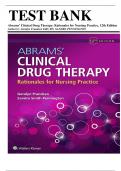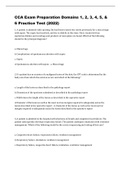TEST BANK Abrams’ Clinical Drug Therapy: Rationales for Nursing Practice, 1 2th Edition Author(s): Geralyn Frandsen EdD, RN, SANDRA PENNINGTON TABLE OF CONTENT Chapter 1, The Foundation of Pharmacology: Quality and Safety ................................ ............................ 4 Chapter 2, Basic Concepts and Processes ................................ ................................ ................................ 15 Chapter 3, Medication Administration and the Nursing Process of Drug Therapy ................................ . 25 Chapter 4, Pharmacology and the Care of Infants and Pediatric Patients ................................ ................ 33 Chapter 5, Pharmacology and the Care of Adults and Geriatric Patients ................................ ................ 41 Chapter 6, Pharmacology and the Care of Pregnant or Lactating Women ................................ .............. 50 Chapter 7, Pharmacology and Women’s Health ................................ ................................ ...................... 60 Chapter 8, Pharmacology and Men’s Health ................................ ................................ ............................ 69 Chapter 9, Drug Therapy for Coagulation Disorders ................................ ................................ ............... 79 Chapter 10, Drug Therapy for Dyslipidemia ................................ ................................ ........................... 88 Chapter 11, Drug Therapy for Hematopoietic Disorders ................................ ................................ ......... 97 Chapter 12, Drug Therapy: Immunizations ................................ ................................ ............................ 106 Chapter 13, Drug Therapy to Decrease Immunity ................................ ................................ ................. 115 Chapter 14, Drug Therapy for the Treatment of Cancer ................................ ................................ ........ 125 Chapter 15, Inflammation, Infection, and the Use of Antimicrobial Agents ................................ ......... 134 Chapter 16, Drug Therapy to Decrease Pain, Fever, and Inflammation ................................ ................ 143 Chapter 17, Drug Therapy With Corticosteroids ................................ ................................ ................... 152 Chapter 18, Drug Therapy With Beta -Lactam Antibacterial Agents ................................ ..................... 162 Chapter 19, Drug Therapy With Aminoglycosides and Fluoroquinolones ................................ ............ 172 Chapter 20, Drug Therapy With Tetracyclines, Sulfonamides, and Urinary Antiseptics ...................... 181 Chapter 21, Drug Therapy With Macrolides and Miscellaneous Anti -infective Agents ....................... 190 Chapter 22, Drug Therapy for Tuberculosis and Mycobacterium avium Complex Disease ................. 198 Chapter 23, Drug Therapy for Viral Infections ................................ ................................ ...................... 207 Chapter 24, Drug Therapy for Fungal Infections ................................ ................................ ................... 216 Chapter 25, Drug Therapy for Parasitic Infections ................................ ................................ ................ 224 Chapter 26, Drug Therapy for Hypertension ................................ ................................ ......................... 233 Chapter 27, Drug Therapy for Dysrhythmias ................................ ................................ ......................... 242 Chapter 28, Drug Therapy for Coronary Heart Disease ................................ ................................ ......... 251 Chapter 29, Drug Therapy for Shock and Hypotension ................................ ................................ ......... 260 Chapter 30, Drug Therapy for Heart Failure ................................ ................................ .......................... 267 Chapter 31, Drug Therapy for Nasal Congestion and Cough ................................ ................................ 276 Chapter 32, Drug Therapy to Decrease Histamine Effects and Allergic Response ............................... 286 Chapter 33, Drug Therapy for Asthma, Airway Inflammation, and Bronchoconstriction .................... 294 Chapter 34, Drug Therapy for Fluid Volume Excess ................................ ................................ ............. 302 Chapter 35, Nutritional Support Products, Vitamins, and Mineral Supplements ................................ .. 310 Chapter 36, Drug Therapy for Weight Management ................................ ................................ ............. 318 Chapter 37, Drug Therapy for Peptic Ulcer Disease and Hyperacidity ................................ ................. 323 Chapter 38, Drug Therapy for Nausea and Vomiting ................................ ................................ ............ 331 Chapter 39, Drug Therapy for Constipation and Elimination Problems ................................ ................ 339 Chapter 40, Drug Therapy for Diarrhea ................................ ................................ ................................ . 347 Chapter 41, Drug Therapy for Diabetes Mellitus ................................ ................................ ................... 355 Chapter 42, Drug Therapy for Hyperthyroidism and Hypothyroidism ................................ .................. 365 Chapter 43, Drug Therapy for Pituitary and Hypothalamic Dysfunction ................................ .............. 373 Chapter 44, Drug Therapy to Regulate Calcium and Bone Metabolism ................................ ............... 382 Chapter 45, Drug Therapy for Adrenal Cortex Disorders ................................ ................................ ...... 390 Chapter 46, Physiology of the Autonomic and Central Nervous Systems and Indications for the Use of Drug Therapy ................................ ................................ ................................ ................................ ......... 399 Chapter 47, Drug Therapy for Myasthenia Gravis, Alzheimer’s Disease, and Other Conditions Treated with Cholinergic Agents ................................ ................................ ................................ ......................... 409 Chapter 48, Drug Therapy for Parkinson’s Disease, Urinary Spasticity, and Disorders Requiring Anticholinergic Drug Therapy ................................ ................................ ................................ ............... 419 Chapter 49, Drug Therapy With Opioids ................................ ................................ ............................... 429 Chapter 50, Drug Therapy With Local Anesthetics ................................ ................................ ............... 437 Chapter 51, Drug Therapy With General Anesthetics ................................ ................................ ........... 444 Chapter 52, Drug Therapy for Migraine and Other Headaches ................................ ............................. 452 Chapter 53, Drug Therapy for Seizure Disorders and Skeletal Muscle Disorders ................................ 461 Chapter 54, Drug Therapy for Anxiety and Insomnia ................................ ................................ ........... 468 Chapter 55, Drug Therapy for Depression and Mood Stabilization ................................ ...................... 477 Chapter 56, Drug Therapy for Psychotic Disorders ................................ ................................ ............... 484 Chapter 57, Drug Therapy for Attention Deficit Hyperactivity Disorder and Narcolepsy .................... 493 Chapter 58, Drug Therapy for Substance Use Disorders ................................ ................................ ....... 501 Chapter 59, Drug Therapy for Disorders of the Eye ................................ ................................ .............. 510 Chapter 60, Drug Therapy for Disorders of the Ear ................................ ................................ ............... 518 Chapter 61, Drug Therapy for Disorders of the Skin ................................ ................................ ............. 526 Chapter 1, The Foundation of Pharmacology: Quality and Safety 1. A woman diagnosed with obsessive –compulsive disorder has been prescribed oral paroxetine hydrochloride. What is the expected effect for this prescription? A. Curative effect on symptoms B. Systemic effect on symptoms C. Local effect on symptoms D. Parenteral effect on symptoms ANS: B Rationale: Drugs that produce systemic effects are taken into the body, circulated through the bloodstream to their sites of action in various body tissues, and eventually eliminated from the body. Curative agents are given to cure a disease process. In this case, paroxetine hydrochloride will control the symptoms but not cure the disorder. Drugs with local effects, such as sunscreen and local anesthetics, act mainly at the site of application. Paroxetine hydrochloride is not administered parenterally. Parenteral agents are administered subcutaneously, intramuscularly, or intravenously. PTS: 1 REF: p. 3, Introduction OBJ: 1 NAT: Client Needs: Physiological Integrity: Pharmacological and Parenteral Therapies TOP: Chapter: 1: The Foundation of Pharmacology: Quality and Safety KEY: Integrated Process: Nursing Process BLM: Cognitive Level: Understand NOT: Multiple Choice 2. A client has been prescribed an antibiotic. This medication is a naturally occurring substance that has been chemically modified. What is another name for this type of medication? A. Synthetic drug B. Semisynthetic drug C. Biotechnology drug D. Prototype drug ANS: B Rationale: Semisynthetic drugs (e.g., many antibiotics) are naturally occurring substances that have been chemically modified. Synthetic drugs are more standardized in their chemical characteristics, more consistent in their effects, and less likely to produce allergic reactions. Biotechnology drugs involve manipulating DNA and RNA and recombining genes into hybrid molecules that can be inserted into living organisms. Prototype drugs are the first drug of a particular group to be developed. PTS: 1 REF: p. 3, Drug Sources OBJ: 1 NAT: Client Needs: Physiological Integrity: Pharmacological and Parenteral Therapies TOP: Chapter: 1: The Foundation of Pharmacology: Quality and Safety KEY: Integrated Process: Nursing Process BLM: Cognitive Level: Understand NOT: Multiple Choice 3. Which classification applies to morphine? A. Central nervous system depressant B. Central nervous system stimulant





